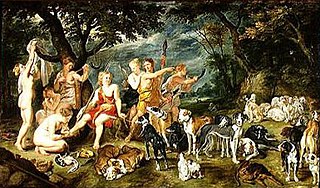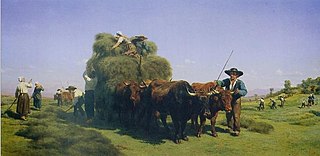 W
WBalaam and the Ass is a 1626 painting by the Dutch artist Rembrandt, dating from his time in Leiden and now in the Musée Cognacq-Jay in Paris.
 W
WThe Blue Nudes is a series of color lithographs by Henri Matisse made from cut-outs depicting nude figures in various positions. Restricted by his physical condition after his surgery for stomach cancer, Matisse began creating art by cutting and painting sheets of paper by hand and supervised the creation of the lithographs until his death in 1954.
 W
WLes Chimères or The Chimaeras is an unfinished painting by the French Symbolist painter Gustave Moreau executed in 1884. It depicts a large forest scene wherein various nude women are associated with sundry figures from classical and medieval mythology –not only the titular chimeras, but also centaurs, winged creatures, fawns, minotaurs, etc. The painting is a philosophical meditation on what Moreau saw as the elemental nature of Woman, depicting the internal yearnings and dreams of women through complex mythological symbolism. Moreau abandoned the work shortly after his mother's death to work on the darker polyptych La Vie de l'Humanité, considered one of his masterpieces.
 W
WA Clinical Lesson at the Salpêtrière is an 1887 group tableau portrait painted by the history and genre artist André Brouillet (1857–1914). The painting, one of the best-known in the history of medicine, shows the neurologist Jean-Martin Charcot giving a clinical demonstration to a group of postgraduate students. Many of his students are identifiable; one is Georges Gilles de la Tourette, the physician who described Tourette syndrome.
 W
WLe Départ des poilus, août 1914 is a monumental mural by the American artist Albert Herter. The painting measures 12 by 5 metres and is displayed at the Gare de l'Est railway station in Paris, where it is suspended some 7 metres (23 ft) high on a wall in the Hall d'Alsace.
 W
WDiana and her nymphs leaving for the hunt is a 1623–1624 oil on panel painting by Peter Paul Rubens (figures) and Jan Brueghel the Elder. It is now in the Musée de la Chasse et de la Nature in Paris.
 W
WHaymaking in the Auvergne is an 1855 oil painting by French artist Rosa Bonheur. It measures 215 cm × 422 cm.
 W
WHenry IV Receiving the Spanish Ambassador is an 1817 painting in the Troubador style by the French painter Jean Auguste Dominique Ingres. It shows Henry IV of France playing with his children whilst receiving the Spanish ambassador, with Marie de Medici seated at the centre.
 W
WJupiter et Sémélé is a painting by the French Symbolist artist Gustave Moreau (1826–1898). It depicts a moment from the classical myth of the mortal woman Semele, mother of the god Dionysus, and her lover, Jupiter, the king of the gods. She was treacherously advised by the goddess Juno, Jupiter's wife, to ask him to appear to her in all his divine splendor. He obliged, but, in so doing, brought about her violent death by his divine thunder and lightning. The painting is a representation of "divinized physical love" and the overpowering experience that consumes Semele as the god appears in his supreme beauty which has been called "quite simply the most sumptuous expression imaginable of an orgasm".
 W
WMemory, the Heart, a 1937 painting by Frida Kahlo, depicts the pain and anguish Kahlo experienced during and after an affair between her husband, artist Diego Rivera, and her sister, Cristina Kahlo.
 W
WMercury Passing Before the Sun is the title of a series of paintings by Italian Futurist painter Giacomo Balla, depicting the November 17, 1914 transit of Mercury across the face of the Sun.
 W
WMountainous Landscape with a Bridge and Four Horsemen is an oil on panel painting by Flemish painter Joos de Momper. Its date of execution is unknown. The painting was once attributed to Paul Bril. It is part of the permanent collection of the Louvre in Paris.
 W
WMountainous Landscape with a Bridge and Four Horsemen is an oil on canvas painting by Flemish landscapist Joos de Momper. Its date of execution is unknown. The painting is kept in the Louvre in Paris.
 W
WL'Oiseau bleu is a large oil painting created in 1912–1913 by the French artist and theorist Jean Metzinger (1883–1956); considered by Guillaume Apollinaire and André Salmon as a founder of Cubism, along with Georges Braque and Pablo Picasso. L'Oiseau bleu, one of Metzinger's most recognizable and frequently referenced works, was first exhibited in Paris at the Salon des Indépendants in the spring of 1913, several months after the publication of the first Cubist manifesto, Du "Cubisme", written by Jean Metzinger and Albert Gleizes (1912). It was subsequently exhibited at the 1913 Erster Deutscher Herbstsalon in Berlin.
 W
WBaronne de Rothschild is an 1848 portrait by the French Neoclassical artist Jean-Auguste-Dominique Ingres. The sitter, Betty de Rothschild (1805–1886) had married her paternal uncle banker James Mayer de Rothschild and was one of the wealthiest women in Europe, and one of the foremost Parisian patrons of the arts. Her beauty and elegance were widely known and celebrated, and inspired Heinrich Heine's poem The Angel. For her portrait, which is painted in oil on canvas, Ingres sought to infuse symbols of her material wealth with the dignity, grace and beauty of Renaissance art, especially that of Raphael, while at the same time adhering to the command of line as practiced by Jan van Eyck. It is this combination which, according to art historians, places Ingres so far apart from his early modernist contemporaries.
 W
WThe Pyramides at Port-Coton, Rough Sea is a series of six paintings produced by Claude Monet in 1886. They all show the rocky Atlantic coast of Belle-Île-en-Mer, visited and painted in the plein air by the artist between 12 September and 25 October that year.
 W
WThe Signs of the Zodiac is a series of twelve allegorical paintings of the signs of the Zodiac, originally painted around 1640 by Jacob Jordaens and bought by the French Senate in 1802 for the ceiling of the east gallery of the Palais du Luxembourg in Paris, then occupied by the Musée du Luxembourg and now housing a library annexe.
 W
WThe Sorrows of the King is a collage using cut out paper shapes by Henri Matisse from 1952. It was made from paper he had coloured with gouache paint and is mounted on canvas. Its area is 292 x 386 cm. It was his final self-portrait. During the early-to-mid-1940s Matisse was in poor health. By 1950 he stopped painting in favor of his paper cutouts. The Sorrows of the King is an example of Matisse's final body of works known as the cutouts.
 W
WSouvenir de Mortefontaine is an 1864 oil-on-canvas painting by French artist Jean-Baptiste-Camille Corot. It is a scene of tranquillity: a woman and children quietly enjoying themselves by a glass-flat, tree-flanked lake.
 W
WWoman Reading is a painting by Henri Matisse from 1896. It is displayed at Le Cateau-Cambrésis, Musée Matisse, deposited by the Centre Pompidou in 2002. It shows the calmness of a reading woman. The painting evokes a calm, relaxing atmosphere.